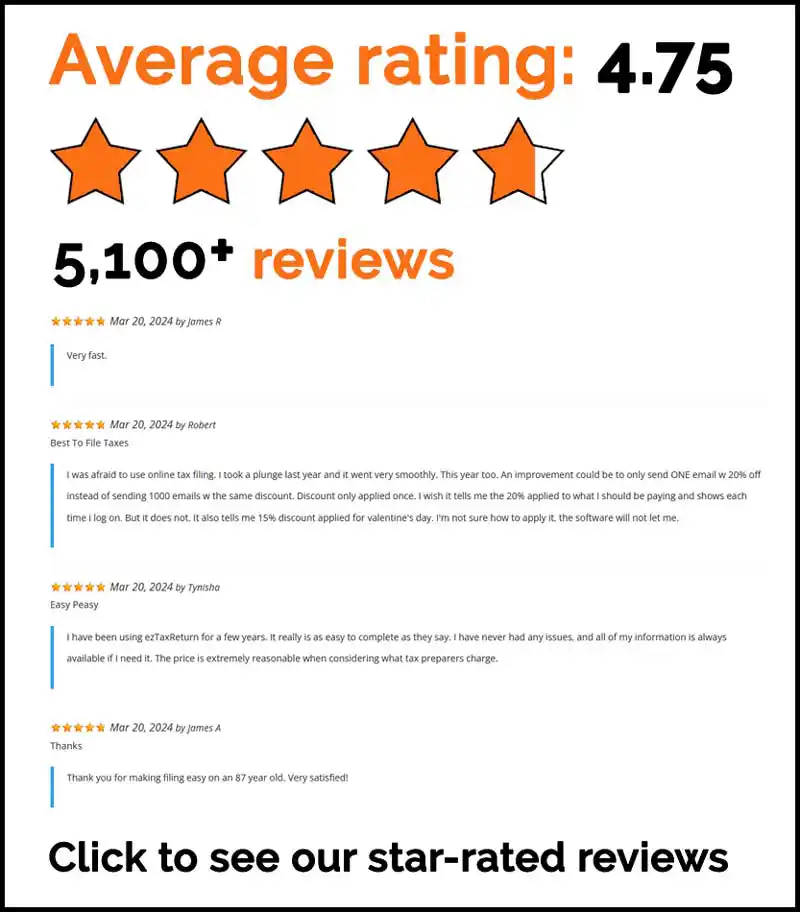Want to increase your tax refund this season? You’re not alone. Most people want to get back as much as they can or at least pay no more than necessary. The hard part is knowing where to start. Luckily, you have ezTaxReturn in your corner. We’ll shed some light on several factors that can impact the amount of taxes you pay each year. With some strategic planning, you’ll be able to increase your tax refund.
Select the Best Filing Status for Your Situation
When you prepare your taxes, one of the first things you’re asked to do is pick a filing status. The one you choose will impact your income tax and refund because it determines your standard deduction amount, tax rate, and the credits and deductions available to you. The five filing statuses are single, married filing jointly, married filing separately, head of household, and qualifying surviving spouse. Here’s a brief explanation of what each one means.
- Single – Taxpayers who are unmarried, divorced or legally separated.
- Married filing jointly – Married couples who choose to file a tax return together.
- Married filing separately – Married couples who prefer to file separate tax returns.
- Head of household – Unmarried taxpayers can choose this status if they paid more than half the living expenses for themselves and a qualifying person at least six months out of the year.
- Qualifying surviving spouse (QSS) – Taxpayers can select this status if their spouse died in the previous two years and they have a dependent child.
Your filing status is determined on the last day of the year. So, whatever your marital status is on December 31st, applies for the entire year. In some cases, you may qualify for more than one status. Go with the one that saves you the most money. For example, unmarried taxpayers who supported a child or elderly parent, may find it more beneficial to file as head of household versus single. The tax rates are lower for head of household and the standard deduction is higher.
Although most married couples file a joint return, there may be times when it’s better to file separately. Let’s say one spouse has a significant amount of medical bills. IRS rules state that you can only deduct the portion of your medical expenses that exceeds 7.5% of your adjusted gross income (AGI). By filing separate, it will be easier to hit your mark because each spouse’s AGI will be lower. Try calculating your return using both scenarios to see which one gives you a better refund. The downside is, if you choose to file separately, you may miss out on some of the credits available to those filing joint. When you file with ezTaxReturn, we’ll do the calculations for you.
Don’t Miss Out on Tax Deductions
Tax deductions reduce your taxable income. You can either apply the standard deduction or choose to itemize deductions based on what benefits you more. As a result, this will either reduce the taxes you owe or increase your tax refund. The key to taking advantage of tax deductions is to make sure you keep good records of all your expenses throughout the year. Writing down every single expense may be tedious, but your records may translate into deductions which lowers your taxable income. For example, educators who paid out of pocket for classroom supplies may be able to deduct up to $300 of unreimbursed expenses. Qualified expenses include books, supplies, computers including software and other equipment. Plus, any protective items you bought to prevent COVID-19 from spreading around your classroom. Other deductions you don’t want to overlook include:
- Student loan interest deduction – Borrowers can deduct up to $2,500 of interest paid on their student loans.
- Charitable contribution deduction – If you itemize, you can deduct your charitable contributions up to 60% of your adjusted gross income.
- Medical expense deduction – You can deduct unreimbursed medical and dental expenses that are more than 7.5% of your adjusted gross income.
- Mortgage interest deduction – Homeowners can deduct the mortgage interest they pay.
- State and local taxes deduction – You can deduct up to $10,000 of property, sales or state and local income taxes.
- Gambling losses deduction – You can deduct your gambling, but you can’t write off more money than you won.
Evaluating opportunities to itemize deductions can be beneficial, especially when you have significant charitable contributions or medical expenses. Strategies such as bunching donations or using donor-advised funds can facilitate itemizing deductions in future tax years.
Claim Available Tax Credits
Tax credits reduce the amount of taxes you owe, dollar-for-dollar, which can significantly increase your tax refund. One of the most popular credits is the Earned Income Credit (EIC) which is potentially worth up to $7,830 for workers with low to moderate incomes. Here are some other popular tax credits available this upcoming season.
- The Child Tax Credit – Families with children under the age of 17 can get up to $2,000 per child with $1,700 being refundable.
- The Credit for Other Dependents – If you have a dependent who doesn’t qualify for the Child Tax Credit, you may qualify for this $500 credit.
- Child and Dependent Care Credit – A credit that helps you pay for the care of a child under age 13, an adult dependent, or an incapacitated spouse. The maximum credit is 35% of $3,000 of expenses for one dependent or $6,000 for two or more dependents.
- American Opportunity Tax Credit – Students or parents who paid for tuition, books, school fees and equipment can get up to $2,500.
- Lifetime Learning Credit – Eligible taxpayers claim up to $2,000 for qualified education expenses such as tuition and required fees.
- Saver’s Credit – Low to moderate income workers who are saving for retirement can get a credit worth 10% to 50% of $2,000 ($4,000 if married filing jointly). The percentage depends on your filing status and AGI.
Maximize Your IRA and HSA Contributions
You have until April 15, 2025 to make contributions to your IRA for 2024. The maximum you can contribute is $7,000. If you’re over 50, you can take advantage of the catch-up provision which means you’re allowed to contribute an extra $1,000 towards your IRA. The contributions you make to a traditional IRA lowers your taxable income. Contributions for the previous tax year can be made up until the tax filing deadline. If you contributed to a Roth IRA, you may be able to claim the retirement savers credit which also lowers your taxable income.
You also have until the tax filing deadline to make contributions to a health savings account (HSA). The HSA contribution limits for 2024 are $4,150. for self-only coverage and $8,300 for family coverage. Those ages 55 or older can add an extra $1,000 as a catch-up contribution. The contributions you make to an HSA are tax-deductible and so are the withdrawals if you use them for qualified medical expenses.
Use Tax Software to Do Your Taxes
Increasing your tax refund is easier than you think, especially when you use tax software. It is built to handle all types of tax situations and can make the filing process go smoother. Tax software provides step-by-step guidance that most people can easily follow, even those with no prior tax knowledge. You’ll answer basic questions about your tax situation and the program will find credits and deductions you may qualify for. It even fills out the correct forms and handles the calculations, so you file an accurate tax return. You can do your taxes fast and ez and get your biggest possible refund by filing with ezTaxReturn.
Plan Ahead For Next Year
Planning ahead is key to maximizing your tax refund. One strategy is to contribute to a traditional IRA or a health savings account (HSA), which can reduce your taxable income and lower your tax bill. You can also make charitable donations or prepay mortgage interest and property taxes to reduce your taxable income. Additionally, consider itemizing your deductions instead of taking the standard deduction, especially if you have significant charitable contributions or medical expenses. By planning ahead and taking advantage of these tax savings strategies, you can increase your tax refund and reduce your tax liability.
Effective tax planning involves looking ahead and making strategic financial decisions throughout the year. Contributing to a traditional IRA or HSA can lower your taxable income, while charitable donations and prepaying certain expenses can further reduce your tax bill. If your qualifying expenses exceed the standard deduction, itemizing your deductions can lead to greater tax savings. By implementing these strategies, you can ensure that you’re maximizing your tax refund and minimizing your tax liability.
The articles and content published on this blog are provided for informational purposes only. The information presented is not intended to be, and should not be taken as, legal, financial, or professional advice. Readers are advised to seek appropriate professional guidance and conduct their own due diligence before making any decisions based on the information provided.




